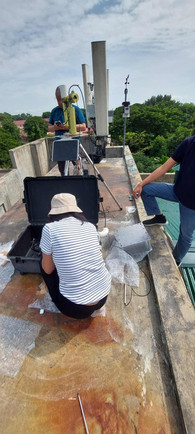NASA’S AERONET STATION ESTABLISHED AT NOTRE DAME OF MARBEL UNIVERSITY, PUTS SOUTH COTABATO IN THE GLOBAL MAP
- Notre Dame of Marbel University

- Aug 13
- 2 min read
The National Aeronautics and Space Administration (NASA) of the United States entered into an agreement with the Manila Observatory at the Ateneo de Manila University to host Aerosol Robotic Network (AERONET) sun photometers in the Philippines. The AERONET (AErosol RObotic NETwork) program is a federation of ground-based remote sensing aerosol networks established by NASA and PHOTONS (Univ. of Lille 1, CNES, and CNRS-INSU) and is greatly expanded by collaborators from national agencies, institutes, universities, individual scientists, and partners. The program provides a long-term, continuous and readily accessible public domain database of aerosol optical, mircrophysical and radiative properties for aerosol research and characterization, validation of satellite retrievals, and synergism with other databases. The network imposes standardization of instruments, calibration, processing and distribution. AERONET collaboration provides globally distributed observations of spectral aerosol optical depth (AOD), inversion products, and precipitable water in diverse aerosol regimes.
To increase the number of sites or stations for monitoring aerosols here in the Philippines and to increase awareness of the effects of aerosols in climate change, the Manila Observatory (MO) and Notre Dame of Marbel University (NDMU) forged a scientific partnership that identifies NDMU, with approval from NASA, as an AERONET station. This partnership envisions the encouragement of scientists from the partner institutions to develop scientific agenda using the data collected from the sun photometer in cooperation with NASA.
While the formal written agreement between MO, represented by Antonia Yulo- Loyzaga the Executive Director and NDMU represented by the President, Bro. Wilfredo E. Lubrico, was then being processed, the sun photometer was already deployed by Dr. Nofel Lagrosas of the Manila Observatory last December 12, 2009 at the roof top of OMER Hall, Science Complex, NDMU. The sun photometer (a robot), powered by solar energy, is programmed to collect certain data at certain times in the day. It automatically downloads data to a computer, which in turn, automatically sends data to NASA via the internet.
The Memorandum of Agreement between the Manila Observatory and Notre Dame of Marbel university was finalized on February 2011.
The persons involved in this project as Principal Investigators are: Dr. Brent Holben (NASA); Dr. Nofel Lagrosas (MO) and; Dr. Susana V. Dorado (NDMU). The persons assigned as Station Managers are: Dr. Susana V. Dorado and Engr. Victorino Tobias both of NDMU.
To date, there are three Aerosol Robotic Network (AERONET) stations deployed in the Philippines. Manila Observatory hosts the one in Quezon City, El Nido Airport houses the station in El Nido, and Notre Dame of Marbel University maintains the unit in Koronadal City. The data is being analyzed alongside cloud information and satellite aerosol observations
For more information about AERONET and view the processed data collected globally and at NDMU station, you may visit the website http://aeronet.gsfc.nasa.gov.
Article by Susana V. Dorado, Ph.D.














Comments